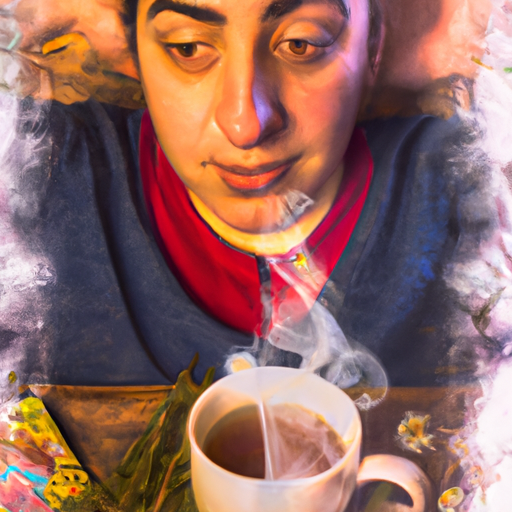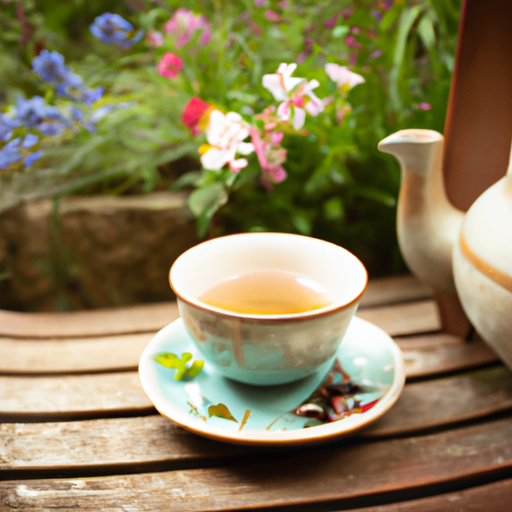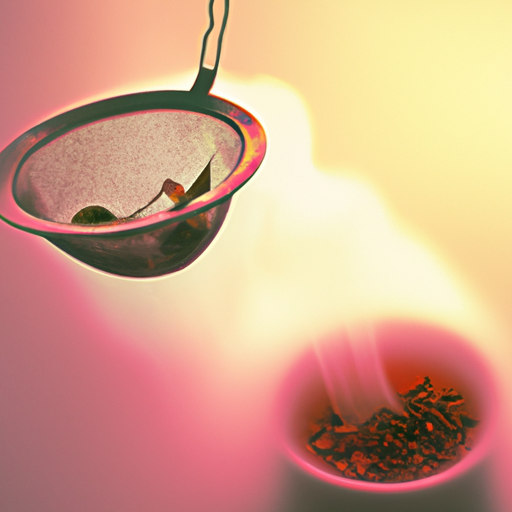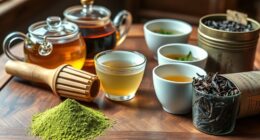Have you ever heard the saying, ‘Don’t judge a book by its cover’? Well, the same goes for herbal bitter tea. It may look unappealing, but trust me, there’s more to it than meets the eye.
As someone who has always been passionate about herbal teas, I’ve discovered some amazing ways to make them taste better, and I can’t wait to share them with you. In this article, I’ll guide you through a journey of transforming your bitter tea into a delightful and flavorful experience.
From choosing the right herbs and blends to experimenting with different brewing techniques, we’ll explore every avenue to enhance the taste of your tea. Whether you’re a tea enthusiast looking to expand your palate or just someone who wants to enjoy a cup of tea without the bitterness, this article is for you.
So, let’s dive in and discover the secrets of making herbal bitter tea taste better.
Key Takeaways
- Choosing the right herbs and blends is crucial for enhancing the taste of herbal bitter tea.
- Adjusting steeping time and temperature can significantly impact the flavor profile of herbal bitter tea.
- Adding natural sweeteners like honey or agave syrup can help balance the bitterness of herbal bitter tea.
- Experimenting with flavor combinations, such as adding fruits, citrus peels, or other teas, can elevate the taste of herbal bitter tea.
Choose the Right Herbs and Blends
Choose the herbs and blends that’ll transform your herbal bitter tea into a flavorful and delightful experience that’ll leave your taste buds begging for more. Herbal tea blends are the key to enhancing the taste of your bitter tea. Whether you prefer a calming chamomile, a refreshing peppermint, or a zesty lemon ginger blend, there’s a wide variety of options to choose from.
Not only do these blends add an aromatic and pleasant flavor to your tea, but they also come with their own set of herbal tea benefits. From boosting immunity to aiding digestion, each blend offers its own unique health benefits. So, explore the world of herbal tea blends and discover the perfect combination that suits your taste buds and improves your overall well-being.
Now, let’s move on to the next step and adjust the steeping time and temperature for a perfect cup of herbal tea.
Adjust the Steeping Time and Temperature
Experimenting with different steeping times and temperatures can yield surprising results in transforming the flavor profile of your herbal bitter tea. It’s fascinating to discover how these variations can enhance or mellow the taste of the tea.
To explore alternative steeping methods, you can start by adjusting the steeping time. For a stronger and more intense flavor, try steeping the tea for a longer period. Conversely, if you prefer a milder taste, shorten the steeping time.
Additionally, don’t be afraid to experiment with different water temperatures. Using hotter water can extract more of the tea’s flavors, while cooler water can bring out subtle notes.
By playing around with these variables, you can create a tea that perfectly suits your taste preferences.
Now, let’s move on to the next step and discover how to add natural sweeteners and flavorings to further enhance your herbal bitter tea.
Add Natural Sweeteners and Flavorings
When it comes to enhancing the taste of herbal bitter tea, I’ve found that adding natural sweeteners and flavorings can make a world of difference. Personally, I love using honey or agave syrup to sweeten my tea, as they not only add a touch of sweetness but also bring their own unique flavors.
Additionally, infusing the tea with fruits or citrus peels can lend a refreshing and vibrant taste that complements the herbal notes perfectly. Trust me, these simple additions can truly transform your cup of tea into a delightful and flavorful experience.
Use Honey or Agave Syrup
To enhance the flavor of your herbal bitter tea, try drizzling a spoonful of honey or agave syrup into your steaming cup. This transforms it into a deliciously sweet elixir, using alternative sweeteners like honey or agave syrup to add a natural sweetness. It counterbalances the bitterness of the tea. The rich, golden hue of honey or the smooth, caramel-like flavor of agave syrup brings depth and complexity to your drink. It’s like adding a touch of magic to your cup, enchanting your taste buds with every sip.
To make it even more enticing, here are a few other ways to elevate the experience:
- Sprinkle a pinch of cinnamon for a warm and comforting aroma.
- Add a dash of vanilla extract to create a heavenly scent.
- Infuse the tea with a few cardamom pods for a delightful exotic twist.
- Garnish with a fresh sprig of mint to refresh your palate.
- Squeeze a splash of lemon juice for a zesty kick.
By incorporating these spices and natural sweeteners, you can turn your herbal bitter tea into a tantalizing elixir of flavors.
Now, let’s move on to the next section and discover how to infuse your tea with fruits or citrus peels.
Infuse with Fruits or Citrus Peels
Enhance your brewing experience by infusing your cup of herbal bitter tea with the vibrant flavors of fruits or citrus peels. Infusing your tea not only adds a burst of refreshing taste, but also brings a whole new level of complexity to your drink.
To infuse with fruits, simply slice your favorite fruits like berries, apples, or peaches, and add them to your tea while it steeps. The natural sweetness and tanginess from the fruits will help balance out the bitterness of the herbal tea, creating a harmonious blend of flavors.
Alternatively, you can also infuse your tea with citrus peels such as lemon or orange, which will add a refreshing and zesty twist to your cup. Don’t forget to experiment with different combinations of herbs and spices to further enhance the taste.
So, let’s move on to the next step and explore how to mix in other teas or ingredients to create your perfect cup of herbal bitter tea.
Mix in Other Teas or Ingredients
Consider blending your herbal bitter tea with a touch of soothing chamomile or a sprinkle of invigorating lemon zest to create a harmonious and vibrant flavor experience. Tea pairing recommendations are endless when it comes to enhancing the taste of herbal bitter tea. You can experiment with different combinations, like adding a hint of earthy green tea or a burst of refreshing mint. These creative herbal tea blends not only balance the bitterness but also elevate the overall taste profile.
The chamomile brings a calming effect while the lemon zest adds a zingy brightness. By incorporating these complementary ingredients, you can transform your herbal bitter tea into a delightful and well-rounded brew.
Now, let’s explore how to enhance the taste with milk or cream to further elevate your tea-drinking experience.
Enhance the Taste with Milk or Cream
Adding milk or cream to your herbal bitter tea creates a velvety smoothness that enhances the flavor and adds a luxurious touch to your tea-drinking experience. It’s a simple yet effective way to transform the taste of your tea and make it more enjoyable.
Here are a few ways to enhance the taste using alternative dairy options:
-
Coconut milk: This creamy and slightly sweet option pairs well with herbal teas like chamomile or lavender, adding a tropical twist to your cup.
-
Almond milk: With its nutty flavor, almond milk complements earthy herbal teas like dandelion or nettle, creating a harmonious and comforting blend.
-
Vanilla creamer: Adding a splash of vanilla creamer gives your herbal bitter tea a hint of sweetness and a smooth, indulgent texture.
-
Honey-infused milk: Mix honey and warm milk together before adding it to your tea for a naturally sweet and creamy concoction.
By exploring different flavor combinations with herbs and alternative dairy options, you can truly elevate your herbal bitter tea experience. Now, let’s delve into the next section and experiment with cold brewing.
Experiment with Cold Brewing
When it comes to enhancing the taste of herbal bitter tea, adding milk or cream can certainly do the trick. However, if you’re looking to try something different, why not experiment with cold brewing? Cold brewing involves steeping the tea leaves in cold water for an extended period of time, resulting in a smoother and less bitter flavor profile. It’s a great option for those who prefer a refreshing and mellow cup of tea.
Additionally, you can also try varying the water temperatures when brewing your herbal bitter tea. Different water temperatures can bring out different flavors and aromas, allowing you to customize your tea to your liking. So, why not give cold brewing and different water temperatures a try? Trust me, you won’t be disappointed.
Now, let’s move on to the next section and explore how to serve herbal bitter tea with some delightful accompaniments.
Serve with Accompaniments
When it comes to serving herbal bitter tea, I love to pair it with delicious baked goods or tempting desserts. The combination of the bitter flavors from the tea and the sweetness from a warm slice of cake or a decadent dessert creates an exquisite balance of tastes in my mouth.
Additionally, I find that enjoying herbal bitter tea with a slice of cheese or a square of dark chocolate is a delightful experience for my taste buds, as the rich and complex flavors of these accompaniments complement the herbal notes of the tea perfectly.
Pair with Baked Goods or Desserts
To truly enhance your herbal bitter tea experience, indulge in the perfect pairing of baked goods or desserts that’ll transport your taste buds to a realm of pure bliss. Here are some delightful options to consider:
-
Pair with fruit compote: The tangy sweetness of fruit compote perfectly complements the herbal bitterness of the tea. Whether it’s a luscious berry compote or a refreshing citrus blend, the combination will create a harmonious balance of flavors.
-
Try with ice cream: The creamy richness of ice cream adds a luxurious touch to the tea. Opt for flavors like vanilla, honey, or lavender to enhance the herbal notes and create a delightful contrast in textures.
-
Enjoy with cheese: The sharp and salty flavors of cheese can beautifully counterbalance the bitter taste of the tea. Choose a mild cheese like goat cheese or a tangy blue cheese to create a tantalizing flavor combination.
-
Savor with dark chocolate: The bitterness of dark chocolate harmonizes with the herbal bitterness of the tea, creating a decadent and sophisticated pairing. Take a bite of rich, velvety dark chocolate and let it melt in your mouth as you sip on the tea, creating a symphony of flavors.
Now, let’s explore how to enjoy your tea with cheese or dark chocolate.
Enjoy with Cheese or Dark Chocolate
After discovering how well herbal bitter tea pairs with baked goods and desserts, I couldn’t wait to explore other delightful combinations. That’s when I stumbled upon the perfect pairing: enjoying herbal bitter tea with cheese or dark chocolate.
The contrast between the bitter notes of the tea and the richness of the cheese or dark chocolate creates a truly indulgent experience for the taste buds.
When it comes to cheese, the possibilities are endless. From creamy brie to sharp cheddar, each cheese brings its own unique flavors to the table. I highly recommend experimenting with different cheeses to find your perfect match. And let’s not forget about dark chocolate – its intense, slightly bitter taste complements the herbal flavors of the tea beautifully.
To elevate this pairing even further, try sipping your herbal bitter tea alongside a glass of wine. The complex flavors of the wine will enhance the overall experience, creating a symphony of taste sensations.
So go ahead, indulge in the luxurious combination of herbal bitter tea, cheese, and dark chocolate. You won’t be disappointed.
Frequently Asked Questions
Can I use any type of herbal tea for making herbal bitter tea taste better?
Sure, any type of herbal tea can be used for flavor experimentation. However, it’s important to note that herbal bitter tea is specifically designed for the digestive benefits it offers.
What is the ideal steeping time and temperature for herbal bitter tea?
The ideal steeping time for herbal bitter tea is 5-7 minutes at a temperature of 200°F. To enhance the flavor without adding sweeteners or flavorings, try adding a squeeze of lemon or a sprig of fresh mint.
Are there any natural sweeteners or flavorings that work particularly well in enhancing the taste of herbal bitter tea?
I love using natural sweeteners like honey or stevia to enhance the taste of herbal bitter tea. Adding a splash of citrus juice, like lemon or orange, can also add a refreshing burst of flavor.
Can I mix herbal bitter tea with other types of tea or ingredients to improve its flavor?
Mixing herbal bitter tea with alternative herbs like mint or chamomile can improve its flavor. Get creative and add fruits like lemon or berries, or spices like cinnamon or ginger, for a more enjoyable taste experience.
Is it possible to use milk or cream to make herbal bitter tea taste better, or should I avoid adding dairy products?
Using honey or lemon to enhance the taste of herbal bitter tea is a great idea. You can also experiment with different combinations of herbs and spices to find the perfect balance of flavors. Adding milk or cream may not be the best option as it may overpower the herbal bitterness.
Conclusion
As I took my first sip of the carefully crafted herbal bitter tea, a wave of complex flavors washed over my taste buds. The bitterness, once overpowering, had transformed into a delicate balance of earthy notes and subtle sweetness.
I couldn’t help but marvel at how a few simple adjustments had taken this tea from ordinary to extraordinary. With each sip, I discovered a new layer of depth and complexity, leaving me craving more. It was a revelation, a reminder that with a little experimentation, even the most challenging flavors can be transformed into something truly remarkable.










